You can Download The Ant and the Cricket Questions and Answers, Summary, Activity, Notes, Samacheer Kalvi 10th English Book Solutions Guide Pdf Poem Chapter 4 help you to revise complete Tamilnadu State Board New Syllabus and score more marks in your examinations.
Attempt all english grammar practice sections covered in the Samacheer Kalvi 10th English Grammar Book and excel in reading, writing, and speaking english with great fluency.
Tamilnadu Samacheer Kalvi 10th English Solutions Poem Chapter 4 The Ant and the Cricket
The Ant and the Cricket Textual Questions
A. Based on your understanding of the poem, read the following lines and answer the questions given below.
(i) “A silly young cricket accustomed to sing
Through the warm, sunny months of gay summer and spring.”
(a) What was the routine of the cricket?
(b) Name the seasons mentioned here.
Answer:
(a) The routine of the cricket was to sing and while away the time enjoying the spring.
(b) The seasons mentioned are summer and winter.
(ii) “Began to complain when he found that, at home,
His cupboard was empty, and winter came.”
(a) Who does ‘he’ refer to?
(b) Why was his cupboard empty?
Answer:
(a) ‘He’ refers to the foolish cricket.
(b) His cupboard was empty because he had not stored any food during summer.
(iii) “Not a crumb to be found
On the snow-covered ground;
(a) What couldn’t he find on the ground?
(b) Why was the ground covered with snow?
Answer:
(a) He couldn’t find even a single piece of bread on the ground.
(b) The ground was covered with snow because of the onset of the winter season.
(iv) “At last by starvation and famine made bold,
All dripping with wet, and all trembling with cold,”
(a) What made the cricket bold?
(b) Why did the cricket drip and tremble?
Answer:
(a) Starvation and hunger made the cricket bold.
(b) The cricket dripped wet and trembled with cold because it was winter.
(v) “Away he set off to a miserly ant,
To keep if, to keep him alive, he would grant
Him shelter from rain,
And a mouthful of grain.”
(a) Whom did the cricket want to meet? Why?
(b) What would keep him alive?
Answer:
(a) The cricket wanted to meet the miserly ant to ask for shelter and food.
(b) Shelter from rain and a mouthful of grain would keep him alive.
(vi) “But we ants never borrow; we ants never lend. ”
(a) Why do you think ants neither borrow nor lend?
(b) Who says these lines to whom?
Answer:
(a) Ants are industrious and good planners. So they neither borrow nor lend.
(b) The miserly ant says this to the silly cricket.
(vii) “Not I My heart was so light
That I sang day and night,
For all nature looked gay.”
(a) Who does ‘I’ refer to?
(b) What was the nature of the cricket? How do you know?
Answer:
(a) ‘I’ refers to cricket.
(b) The nature of cricket is to sing day and night and be happy.
(viii) “Thus ending, he hastily lifted the wicket,
And out of the door turned the poor little cricket,”
(a) The ant refused to help the cricket. Why?
(b) Explain the second line.
Answer:
(a) The ant refused to help the cricket since they will end up in starvation giving food to the silly cricket.
(b) Since the ant closed the door, the poor little cricket had to turn and go away.
(ix) “He wished only to borrow;
He’d repay it tomorrow;”
(a) Pick out the rhyming words in the above lines.
(b) Give more examples of rhyming words from the poem.
Answer:
(a) The rhyming words in the above lines are borrow and tomorrow.
(b) Sing-spring; home-come; found-ground; see-tree-me; bold-cold; ant-grant; rain-grain; tomorrow-sorrow; ffiend-lend; by-I; light-night; gay-say-away; wicket-cricket and true-two are the rhyming words.
(x) “My heart was so light
that I sang day and night,
For all nature looked gay.
“You sang, Sir, you say”?
(a) Mention the rhyme scheme employed in the above lines.
Answer:
aabb’ is the rhyme scheme.
Additional Questions
(i) “A silly young cricket, accustomed to sing
Through the warm, sunny months of gay summer and spring,
Began to complain when he found that, at home,
His cupboard was empty, and winter has come.”
(а) What are the two qualities of Cricket described here?
(b) What is the weather condition in the above lines?
(c) What do you understand by the word, ‘accustomed’?
(d) Why has the young cricket been called silly?
(e) How did he spend his summer and spring?
(f) What did he find in winter?
(g) Write the rhyming words.
Answer:
(a) The two qualities to describe the cricket in this poem are foolish cricket and singer cricket.
(b) The weather condition is dry summer and cold winter.
(c) Accustomed means ‘used to’.
(d) The young cricket has been called silly because he sang day and night all throughout the warm weathers. He made no provisions for the future.
(e) He spent his summer and spring singing all day and night.
(f) He found his empty cupboard without any food to eat in winter.
(g) The rhyming words are ‘sing-spring’ and ‘home-come’.
(ii) “Not a crumb to be found
On the snow-covered ground;
Not a flower could he see,
Not a leaf on a tree.
“Oh I what will become, ” says the cricket, “of me ?”
(a) Who was looking for the crumbs?
(b) What did the Cricket usually do?
(c) Why did he suffer unable to find neither a flower nor a leaf?
(d) When does the cricket ask “Oh! What will become of me?” and why?
Answer:
(a) The cricket was looking for the crumbs.
(b) The cricket usually sang without any thought for the future.
(c) He suffered because he was lazy and careless and not making any plan or provision for the future. He wasted his time when the weather was fine and so starved in the winters as food was covered with snow.
(d) The cricket asks these words when he was in his home looking at the empty cupboard because he finds no food to eat in winter.
(iii) “At last by starvation and famine made bold,
All dripping with wet, and all trembling with cold,
Away he set off to a miserly ant,
To see if, to keep him alive, he would grant”
(a) Who was suffering from starvation and famine?
(b) Why was he ‘dripping with wet’?
(c) Whom did the cricket approach for help?
(d) What did he expect to get from the miserly ant?
(e) What does the word ‘grant’ mean?
(f) Why had the cricket to suffer in winter?
Answer:
(a) The cricket was suffering from starvation and cold.
(b) The winter season was cold and he had no shelter. Hence the cricket was dripping with cold. .
(c) The cricket approached a miserly ant for help.
(d) The cricket expected to get food and shelter from the miserly ant.
(e) Here ‘grant’ means ‘give’.
(f) The cricket had to suffer in winter because of his lazy and careless nature. He was not wise enough to plan the future and store food for the winter season.
(iv) “Him shelter from rain,
And a mouthful of grain.
He wished only to borrow;
He’d repay it tomorrow ;
If not, he must die of starvation and sorrow.”
(a) Who is ‘Him’ in the first line?
(b) What did he want?
(c) From whom did he hope to borrow?
(d) What does the word ‘borrow’ refer to?
Answer:
(a) ‘Him’ refers to the cricket who needs shelter from the ant.
(b) The cricket wanted a mouthful of food and shelter from rain.
(c) The Cricket hoped to borrow from the ant.
(d) The word ‘borrow’ refers to taking money from someone.
(v) “My heart was so light
that I sang day and night,
For all nature looked gay. ” “For all nature looked gay”.
“You sang, Sir, you say?
Go then”, says the ant, “and dance the winter away”.”
(a) Whose heart was light?
(b) What did he do out of joy?
(c) What is meant by ‘gay’?
(d) Why does the poet say that the nature looks gay?
(e) Explain the phrase, ‘dance winter away’.
(f) The ant tells the cricket to “dance the winter away.” Is the usage of the word ‘dance’ appropriate here? If so, why?
(g) Give the rhyme scheme.
Answer:
(a) The cricket’s heart was light.
(b) Out of joy, the cricket danced the winter away.
(c) ‘Gay’ here means ‘happy and joyful’.
(d) The poet says that nature looks happy because it’s springtime.
(e) The phrase ‘dance winter away’ means dancing all through the winter season.
(f) The word ‘dance’ here means ‘merrymaking and wasting time.’ It is appropriate here. Irresponsible cricket does not deserve any sympathy.
(g) ‘aabbb’ is the rhyme scheme.
(vi) “Folks call this a fable. I’ll warrant it true;
Some crickets have four legs, and some have but two”
(a) Who is ‘I’ here?
(b) What is a fable?
(c) ‘…some have but two.’ Who are referred to here?
(d) What is the figure of speech in the second line?
Answer:
(a) The poet is ‘I’ here.
(b) A fable is a short poem or a legend that imparts a moral lesson. It is not based on truths. It often has animals as characters.
(c) The crickets are referred to here.
(d) The figure of speech in the second line is Metaphor- ‘some have but two’. ‘Some’ crickets that have two legs refer to human beings who are as lazy and careless as the cricket. So the Cricket is compared indirectly to the lazy human beings who are two legged.
B. Based on your understanding of the poem, complete the summary using the phrases given below.
In this narrative poem, the poet brings out the idea that is essential for every creature. He conveys this message to the readers through a story of (a) ……………… The ant spends all its summer saving (b) ……………. The cricket (c) …………….. happily in the summer. He (d) …………………. anything for the winter. When winter comes, he is worried that his (e) ……………… is empty. So, he seeks the help of the ant to have (f) ……………… and a (g) …………… to stay. The cricket was even prepared to repay it in the future. The ant made it clear that ants (h) ……………. He also enquired the cricket if it had saved anything when the weather was fine. The cricket answered that it had sung day and night enjoying (i) …………. The ant threw the cricket out and stated in a stem voice it should dance in the winter season too. In his concluding lines, the poet affirms that this is not (j) ………….. but it is true and applicable to (k) …………….. also.
(the pleasant nature, human beings, doesn’t save, warm place, kitchen cupboard, just a fable, saving for future, some grains, never borrow or lend, an ant and a cricket, sings and dances)
Answers:
(a) an ant and a cricket
(b) some grains
(c) sings and dances
(d) doesn’t save
(e) kitchen cupboard
(f) saving for future
(g) warm place
(h) never borrow or lend
(i) the pleasant nature
(j) just a fable
(k) human beings
C. Answer each of the following questions in a paragraph of 120-150 words.
Question 1.
‘Some crickets have four legs and some have two’. Elucidate this statement from the poet’s point of view.
Answer:
Introduction:
In this narrative poem, the poet brings out the idea of hard work. The poem is about a wise, hard-working ant and careless Lazy cricket. Though two-legged some of us behave like four-legged cricket.
Life of the cricket:
Once an ant and a cricket lived in a forest. The cricket was fun-loving. It enjoyed singing all through the summer. It did not plan for winter. Then the winter season came. The snow fell down and covered the earth. Cricket could not find any food.
Life of the ant:
The ant was hard working. The ant had stored grains in its shelter. The ant cared for its future. It saved food in summer. It never borrows or lends. It knew the value of work. It enjoyed the winter.
Cricket’s plea:
The cricket was hungry. It trembled with cold in the snow. So it wanted to meet the ant to get some grains from it. But the ant made it clear that ants never borrow or lend.
Ant’s refusal:
The ant did not want to help the lazy cricket. It closed its small gate. It could not tolerate the careless lazy cricket. It drove it out of its place without giving anything.
Conclusion:
Through this fable, the poet teaches a lesson to human beings. We must work hard, earn money and save something for future.
Moral: ‘Hard work is the key to success”.
Question 2.
Compare and contrast the attitude of the ant and the cricket.
Answer:
The poem, ‘The Ant and the Cricket’ is about a careless cricket and a hardworking ant. We all know that ants are hardworking creatures but on the other hand the Cricket is portrayed as a lazy being. He made no efforts to plan for the future. Thus, the cricket is shown as a young and silly creature because he sang all through summer and spring with no worries in the world for winter that was to come. But when winter arrived, he began to complain that he would die of starvation and hunger.
He found that his cupboard was empty and not a piece of bread to eat. He neither found a leaf, nor a flower. Everything was covered with snow. Therefore, the cricket cried and moaned as he perceived his bad future. Finally, deprived of hunger and starvation, being all wet and cold, the cricket journeyed to the house of the stingy ant becoming bold by nature. He begged for food and shelter but the Ant is wise, foresees its needs for winter and prudently turned down the foolish Cricket.
The Ant clearly stated that Ants neither borrow nor lend. So the Ant is shown as a straightforward and outspoken personality. Perhaps the cricket here is portrayed as a person who makes false promises and the Ant is portrayed to be a strong personality not carried away by the false promises of one. Therefore the Ant could never be exploited though it was humble enough to admit it to be a servant and friend of the Cricket. The Cricket was surely careless and reckless against the Ant who was judicious, discrete, and level-headed.
‘Accept responsibility for your life. Know that it is you who will get you where you want to go, no one else.’
Question 3.
If given a chance, who would you want to be the ant or the cricket? Justify your answer.
Answer:
Introduction:
In this poem, we are seeing about an ant and a cricket. If a chance is given. I would be an ant. Let us see what happens if I would be an ant.
Being an Ant:
An ant is wise and active. It works hard. It plans for the future. It saves food for the future. It teaches us a lesson of hard work. We heed to have the ant as our role model. We must also save for the future from our eargjjagsrTfirough this we can live comfortably in old age. We need not depend on others for food like cricket in the poem.
Poet’s advice:
There are people who live like cricket. They are foolish and lazy to loiter and waste their time. They never work hard. In the future, they suffer a lot for the money. The poet tells that these people are like two-legged crickets. They are worse than the four-legged crickets. The poet advises us to be an ant and not a lazy cricket.
Conclusion:
So, we must be like an ant and not cricket. We must have the foresight of good and bad times ahead in the future.
Additional Questions
Question 1.
What is the Theme and moral of this poem?
Answer:
The theme of the poem, The Ant and the Cricket is hard work versus laziness. Through the story of the silly cricket, which is also lazy and the wise and industrious ant, the poet teaches us the virtue of hard work. The cricket was foolish enough not to see the imminent needs. He made no plans or supplies for the future. He lived in the present moment. The ant, on the other hand, was wise and hardworking. She worked hard so that she could relish the future. The poet wants us to leam a significant lesson in life.
One must always save for the future. One should not be thoughtless and just enjoy the present moment. You will reap only what you sow. Therefore, we must be foresighted enough to see our future and consequently make plans. One should be ready to face anything in life – be it good or bad. The moral of the cricket’s story is also similar to the theme. One should not be lazy and careless about one’s life and future. Hard work is the key to success. One must leam to save for the future.
‘Self-belief and handwork will
always earn you success. ’
Question 2.
Narrate the fable of ‘The Ant and the Cricket’ in your own words.
Answer:
The silly young cricket was fun-loving. He used to sing all through the pleasant sunny months of summer and spring. He was short-sighted. He didn’t bother to store food for the rainy season and cold winter. When the earth was covered with ice and snow, he found that he had nothing to eat and his cupboard was empty. There were no flowers nor leaves on the trees.
He grew nervous. Starvation could be seen over his face. Wet with the rain and shivering with cold, the hungry cricket went to an ant to get shelter and food. He made it clear that he would return the borrowed grain the next day. With humility, the miserly ant said that he was surely the servant and friend of the cricket. But as a matter of principle, the ants neither borrow nor lend. He asked why he never bothered to store something for the rainy day. The cricket admitted that he had been careless and foolish. He enjoyed the beauties of summer and sang merrily. The ant then told him bluntly to go and dance all winter and turned the poor cricket out.
‘Prudence is foresight
and farsightedness.’
The Ant and the Cricket (Adapted from Aesop s fables)
Literary Devices At A Glance (Figures of Speech)
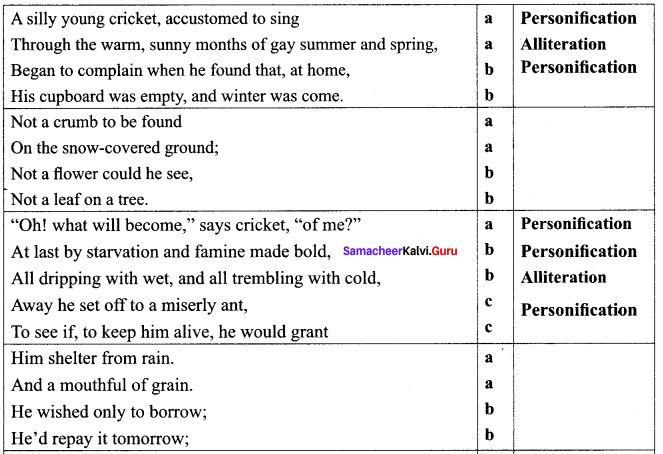
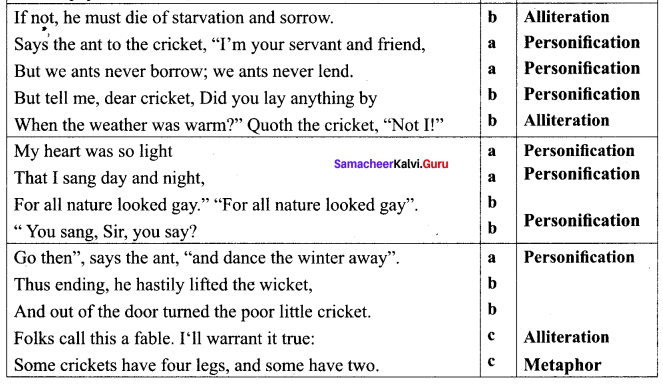
The Ant and the Cricket by Aesop’s Fables About the Poet:
Aesop’s Fables, or the Aesopica, is a collection of fables credited to Aesop, a slave and storyteller believed to have lived in Samos, a Greek island but others say he came from Ethiopia. The name Aesop is derived from the Greek word Aethiop which means Ethiopia! Aesop’s fables were not believed to have been written as Children’s literature and the book of fables were originally used to make thinly disguised social and political criticisms. The similarity to parables or allegories can be seen in most of the short tales in Aesop’s Book of Fables.
The Ant and the Cricket Summary:
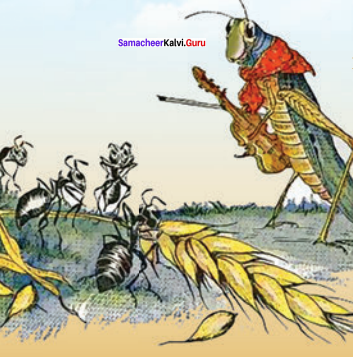
Introduction:
The poem, ‘The Ant and the Cricket’ is about a careless cricket and a hardworking ant. We all know that ants are hardworking creatures. The cricket, on the other hand, was a lazy being which sang day and night and made no efforts to plan for the future.
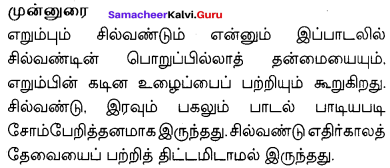
Irresponsible Cricket:
There was a cricket who loved singing. The poet says the cricket is young and silly because he sang all through summer and spring with no worries in the world. But when winter arrived, he began to complain. He found that his cupboard was empty and not a piece of bread was there to eat. He neither found a leaf, nor a flower. Everything was covered with snow. Therefore, the cricket cried as he perceived his bad future.
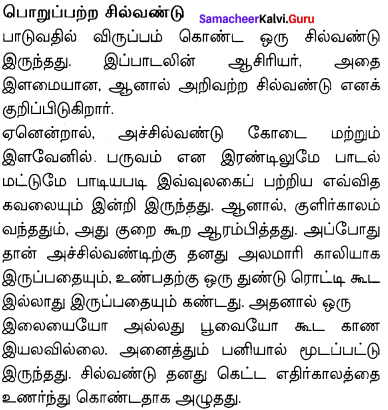
Cricket asks for help from the ant:
Finally, deprived of hunger and starvation, being all wet and cold, the cricket journeyed to the house of a stingy ant. He wanted to know if the ant would lend him a shelter from the rain and a mouthful of grain. He promised that he would repay the ant as soon as he could. He was sure to die of hunger and pain if he didn’t do it.
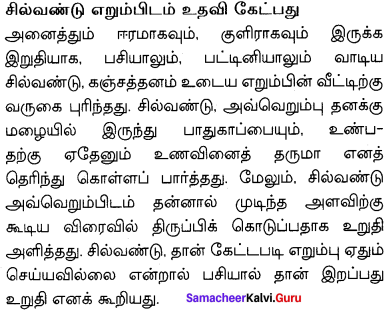
Cricket’s careless reply to ant’s questions:
The ant said to the cricket that he is his servant and friend. However, ants never borrow nor lend. He asked the cricket why he did not store even a single grain of food when the weather was warm. To such a stimulating question, the cricket carelessly replied that he sang day and night as his heart was light and happy and hence never thought of storing food. The ant disapproved the cricket’s reply and told him to go and dance the winter away.
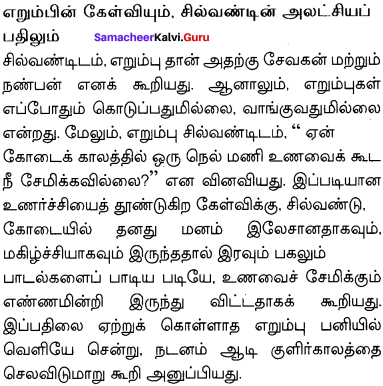
The Ant’s final reply and the state of Cricket:
Thus, completing the conversation, the ant quickly closed the door and turned the poor little cricket out of the house. People call this a legend, but, the poet says that he assures it is true that some crickets have four legs and some crickets have two.
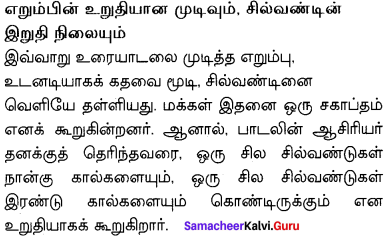
Conclusion:
The poet endorsed the idea of hard work. Hard work fetches fortune. The lazy nature of the Cricket was the reason behind his misfortune. Therefore one has to think ahead and work for safety and comfort. Dependence may not help every time.
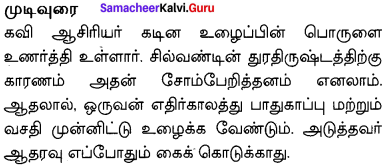
The Ant and the Cricket Glossary:
Textual:
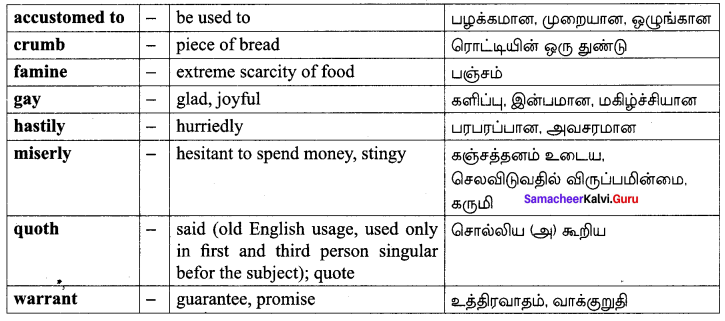
Additional:
